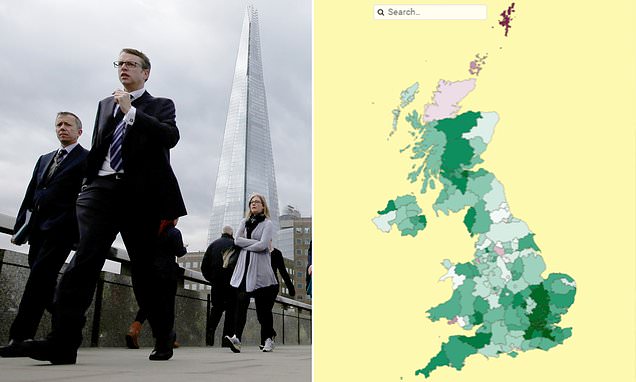Interactive map reveals areas which have seen the most pay growth since the coronavirus pandemic… so how was your region affected?
Pay growth since the start of the pandemic has been strongest for high earning finance and business services workers in London while the rest of the country has fallen behind, a new analysis found today.
The Institute for Fiscal Studies said that between February 2020 and May 2023 mean earnings for employees living in London had risen by 5 per cent after adjusting for inflation, while those within commuting distance of the capital enjoyed a rise of 4.5 per cent.
Both figures were far above the average national increase of 2.7 per cent, contributing to a rise in regional pay inequality. The Shetland Islands fared worse with a 3.3 per cent decrease in mean pay, bringing average monthly earnings to £2,909.
The mean salary in London is now £4,400 a month before tax – or £52,800 a year – compared to £2,504 in Birmingham, £2,521 in Manchester and £2,592 in Glasgow.
Low earning areas include Cornwall (£2,253), Sunderland (£2,425), South Teesside (£2,405), Barnsley, Doncaster and Rotherham (£2,421), Gwynedd (£2,261) and Fermanagh and Omagh (£2,282).
*SEARCH THIS MAP TO SEE THE MEAN EARNINGS IN YOUR LOCAL AREA*
The Institute for Fiscal Studies said that between February 2020 and May 2023 mean earnings for employees living in London had risen by 5 per cent
‘Inequality in mean earnings across the country had been falling in the two decades leading up to the pandemic, with the poorest areas seeing the highest pay growth.
What’s the difference between a mean and median average?
Mean – The number you get by adding up all the numbers in a set and then dividing by how many values there are.
Median – The ‘middle’ value, which you get by listing a series of numbers in ascending order and picking the one in the middle.
‘Since 2020 we have seen a reversal of this trend,’ said Xiaowei Xu, a senior research economist at the IFS.
London has seen a particularly large increase because pay growth since 2020 had been strongest in sectors concentrated in the capital, such as finance, professional services and information technology, the IFS said.
Overall, the energy sector saw the highest mean pay growth of 9.8 per cent, bringing mean pay in May 2023 to £5,199 a month – according to PAYE data from Her Majesty’s Revenue and Customs.
This followed a rise in fossil fuel prices in the aftermath of Russia’s invasion of Ukraine.
By contrast, mean pay for employees working in real estate was down 3.9 per cent to £3,005 a month.
As Ms Xu pointed out, the fact that mean earnings have increased most in London does not imply that everyone in the capital has had a big pay rise.
READ MORE – Workers in Britain are £11,000 worse after 15 years of ‘wage stagnation’
Despite strong growth in mean earnings, median pay was up only 1.7 per cent since the start of the pandemic to £2,700 a month before tax.
As a result, wage inequality in London has increased.
This contrasts with elsewhere in the country, where middle earners have generally fared better than those at the top, leading to a narrowing of pay inequality in these areas.
The analysis suggests mean earnings in low-paid sectors such as hospitality and logistics have fallen in real terms since 2020, despite them being subject to acute labour shortages.
Source: Read Full Article

